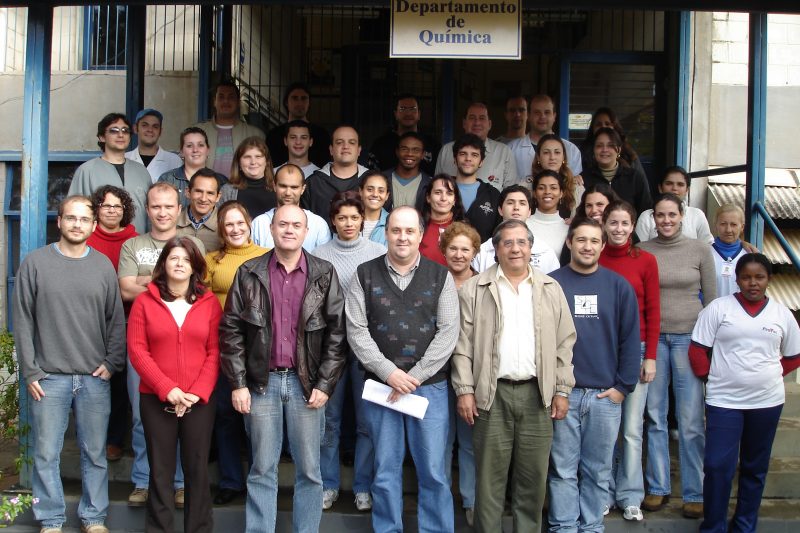The Interdisciplinary Laboratory of Electrochemistry and Ceramics (LIEC) of the Federal University of São Carlos (UFSCar) is completing 30 years of scientific research, development of innovative products and processes, training of scientists and extension activities.
The idea of creating an interdisciplinary laboratory emerged in 1988, from discussions of three research professors, two from UFSCar and the third from UNESP – Araraquara, with education background in chemistry, physics and physical chemistry. These professors were Elson Longo da Silva, Luís Otávio de Sousa Bulhões and José Arana Varela (deceased in 2016). “The idea came about because we had obtained equipment from funding agencies, but there was not enough space in our respective departments to allocate them,” recounted Elson Longo, now professor emeritus of UFSCar, during the commemoration of the anniversary of LIEC, on March 23.
The idea was materialized thanks to a partnership with Companhia Brasileira de Metais e Metalurgia (CBMM) to finance the construction of the building that would house the equipment. The company, Longo said, was interested in the future laboratory developing some products. “Fortunately, we secured their support for the construction of the building at UFSCar,” explained Longo
Soon after, the laboratory began to receive students interested in participating in the research. The first ones, recalls Longo, were Edson Roberto Leite (now professor at UFSCar), Carlos Alberto Paskocimas (currently at UFRN) Ernesto Chaves Pereira (UFSCar) and Maria Aparecida Zaghete (UNESP). “It can be said that over the past 30 years there have been hundreds of students who have completed their studies at LIEC,” said Longo. In addition to students from various UFSCar courses, LIEC has received young people from other institutions in Brazil and abroad for classes, courses and research at all levels of education.
Partnerships with the industrial sector have marked the history of LIEC in the following years. “The various research themes have been developed, and also changing, from theoretical reflections and from contacts with various companies,” declares Longo. “I emphasize that it was not the production of reflexive knowledge of business needs; on the contrary, such needs have given rise to new interpretive models and dialogues with other theories,” he clarifies.
One of the longest-standing industrial partners is Companhia Siderúrgica Nacional (CSN), with which the laboratory continues to work. Initially, LIEC helped the company eliminate the corrosion that the ceramic burner experienced. “The solution to this problem put the team to research and solve problems related to blast furnace, race channel, torpedo car, converter etc.,” Longo recalled.
Another example cited by Longo is the partnership with 3M of Brazil. LIEC collaborated with the company in the implementation of a varistor plant in Ribeirão Preto, some 100 km from São Carlos. “This collaboration allowed us to open another research sub-area, whereby we produced the first tin oxide varistor,” added the professor emeritus.
Parallel to the projects with companies, LIEC carried out, from the beginning, research in structural ceramics based on zirconia oxide stabilized with rare earths and alkaline earth metals. Thus began the collaboration of the laboratory with the theoretical chemist Juan Andrés, professor of the Universitat Jaume I (Spain) – a cooperation that has lasted for 29 years.
As for the extension activities, LIEC also has successful examples, such as the project through which it brought technical knowledge to artistic ceramics artisans from 9 Brazilian states.
In the 21st century, from multidisciplinary laboratory to materials development center
The year 2000 was a turning point in the scientific trajectory of LIEC. The laboratory was approved in the call for FAPESP CEPID projects, and denominated as Multidisciplinary Center for the Development of Ceramic Materials (CMDMC), and with the guarantee of continuous financing for 11 years. Consequently, the area of diffusion of knowledge was created, international collaborations multiplied (covering more than a dozen countries), and support was given to creating spin-off companies. From this environment came Nanox, specialized in bactericidal nanoparticles, and CosmoScience, dedicated to the characterization of cosmetics.
“This is when LIEC initiated comprehensive modifications in the research of ceramic semiconductors using the Pechini method,” Longo said. “There has been significant expansion in the research on piezoelectric materials, sensors, nanometric particles and thin films for non-volatile memory applications,” affirmed LIEC’s founder.
In 2013, LIEC was again contemplated with the FAPESP CEPID project, now denominated the Center for the Development of Functional Materials (CDMF). In this phase, which continues to this day, the diffusion of knowledge has grown remarkably through the use of social networks and the creation of videos, educational games and radio and television programs. In addition, LIEC researchers have established two spinoffs, NChemi Nanomaterials, of nanomaterials, and Katléia, which specializes in capillary diagnostics. In the scientific research activities, the laboratory has concentrated efforts in obtaining semiconductor nanoparticles with controlled reaction kinetics and morphology.
During the event of the 23rd, Professor Longo thanked everyone who built and still builds the history of LIEC, as well as UFSCar and the funding agencies CAPES, CNPq, FAPESP and FINEP. Finally, Longo addressed a few words to the new generations of researchers who will continue the work. The emeritus professor recommended that they plant new seeds for other crops, and that they create their own models and reinvent themselves.
The emeritus professor’s speech ended with this message: “In these moments of moral and ethical crisis that our country experiences, allied to a silent project of dismantling research and public education at all levels, it is imperative that we gather energies for many present and future confrontations”.

